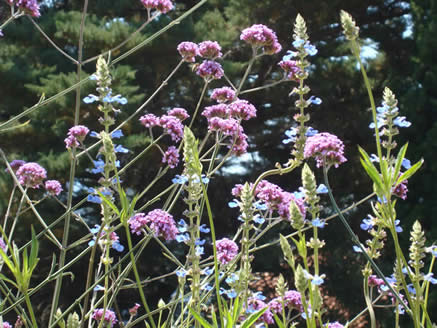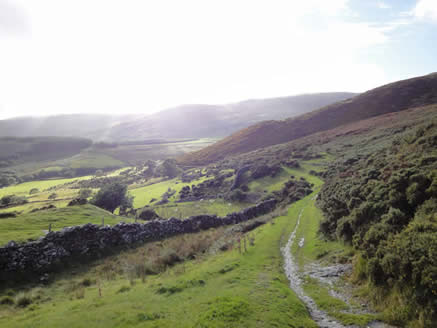Fiat lux
17 September 2010
'What the eye don't see the 'eart don't grieve over' (for full effect, say it in an Aylesbury accent circa 1930). It was the first rule of life I remember nanny teaching me, as she wiped a bit of no-matter-what off the nursery floor with the hem of her apron.
I often repeat it as I go round the garden, rejoicing that a good percentage of it comes into the 'eye don't see' category. Maybe 10 per cent, maybe 15. It lies under old shrubs, at the backs of borders, under the skirts of trees, or where ivy has covered the ground with an impenetrable carpet. Occasionally, and often in autumn when the need for hacking back is most obvious, I poke my nose in, hoping not to find a body, and peer through the gloomy tangle to see what's going on. I have been rewarded with useful, even interesting, seedlings. But sometimes the
Rentrée
13 September 2010
Every gardener should go away on holiday from time to time to clear his vision. Familiarity breeds content - and content (or acquiescence) is not good for a garden. The end of summer is a good time to make a break, see different and foreign gardens, collect ideas and come home with resolutions. It worked perfectly this year. The first of September was the beginning of autumn, as clearly as if a bell had been rung. Three inches of rain in August had given plants a spurt in height and bulk until borders were bulging - not always with the right elements or in the right places. Suddenly it was the salvias and dahlias and big yellow daisies that had the limelight - and in the deep green grass the cyclamen.
alvias get more column inches in this diary than they should. I am captivated by their variety, their easiness in cultivation and the length of their flowering season. The snag, particularly it seems this year, is that many of the ones from subtropical parts are unconvinced by our summer and only really start to perform when it ends. Our September rentrée found some of them, notably my new South African recruit from Vergelegen, still growing rapidly but flowerless. S. splendens,
Warp and weft
10 September 2010
If I needed to turn my back for a while to see the garden clearly in focus again, I also needed inspiration from a fresh creative eye. Bang on cue landed a book I had been looking forward to for a year: a pictorial account of a famous weaver's garden on Long Island by California's most perceptive gardener, photographer and critic, Molly Chappellet.
The name of Jack Lenor Larsen is to fabrics what Armani, say, or Yves St Laurent is to couture. He has been growing his garden in East Hampton for forty years, integrating it with his airy house and astonishing collection of (mainly modern) sculpture. All his life he has worked with weavers in different cultures, from Africa to the Far East to Scandinavia and the Americas. He pulls all these threads together with a weaver's eye, in which wit, it seems to me, plays a large part.
Rate of change
26 August 2010
A noble one-stone henge greets us as we descend into our wooded valley in North Wales. We extracted the thick slab of brown granite from the roadside and set it up at the entrance to the forest when we arrived 15 years ago. This time, though, we had a shock : some anonymous artist has defaced it with a huge white eagle – at least I think that’s what it is. At first sight it looked more like a swastika.
We have washed off what we can of the paint but the shape is still there. I’d like to know more about it, but no one seems to know. Is it the sign of some Welsh anti-English underground ? I’ve never seen it before, and neither have our Welsh friends and neighbours. Perhaps it is just the invention of the artist faced with a tempting blank stone surface ; in which case chapeau to him for an icon combining the Prussian eagle of the First World War with the swastika of the second. If we ever meet I’ll know him by his tattoo.
It won’t be too long, though, before the rain and the lichens erase his work. Speed of change is the thing that always strikes me most in the timeless sheltered world of the forest. Saplings double their height while your back is turned. Paths grow over in a season with grass, rushes, bracken, brambles, gorse and birch. Moss covers tree trunks and conceals rocks. Our latest contribution to the cycle of alteration is a new track to give us
Sigh of relief
17 August 2010
The garden that welcomed us home had had a personality change in the week we were away. The borders are looking blurred compared with the rather stark, if bright, stressed-out look they wore: new growth has rounded and softened them, and new colours and new scents clearly mark the change of season.
Phlox, long delayed by lack of water, is now a major player. 'White Admiral' jostles with deep purple monkshood under a golden veil of the irreplaceable Stipa gigantea. Pink and white Japanese anemones are opening. Salvias bethellii (magenta) and Guanajuato (piercing blue) are clocking on for duty. Now it’s the turn of agapanthus, deep blue
and washed-out grey, Geranium
|
reward is an idea for something better. Even for abolishing the 'don't see' zone altogether.
There is a proper mean between a judicious mingling of plants and each one having its own space. We have a rather splendid old Judas tree, a good forty feet across, two of its branches supported by props. It was planted in 1959, in an enthusiastic fit of planting by our predecessor at Saling. Over fifty years many good trees and shrubs have united in one canopy, the Judas tree included. Once I had decided it was time to let the light in, the cutting back would have done credit to the Coalition and the piles of branches were prodigious.
An amelanchier has been cut down to the stump, a photinia the same, also a Chinese privet; a clerodendron abolished altogether and a score of bottom branches lopped from a Cryptomeria and one of those Lawson cypresses that seem to droop with exhaustion. We have taken perhaps ten feet off the diameter of the Judas tree, letting the light flood in to its handsome undercroft. At the same time we have de-ivied the adjacent tea house. The effect is revolutionary. I see the components of the scene as mature individuals framing delicious glimpses instead of a 'don't see' zone. And there is a glorious bonfire waiting.

Salvia uliginosa mingles with Verbena bonariensis
S. calcaliifolia (small flowers of brightest blue among lush green leaves), S. madrensis (yellow, on strong plants almost worth it for their foliage), even the sky-blue S. uliginosa are merely finding their places in the score and clearing their throats.
In Scotland, where they have less heat but more summer rain, salvias seem to get down to it earlier. But this year I have the feeling that half the plants in the garden were put on hold for almost a month in July; I don't have the figures to prove it, but surely everything is happening late.
The Long House garden is on a big scale; flowing rather than episodic, full of big vistas and big events. Inevitably most of the trees are natives, from oaks and birches to the juniper (Juniperus virginiana) locally known as 'cedar'. Part is sand-dunes, another part a monumental hornbeam alley, another an amphitheatre surrounded by strange monumental bronzes. One celebrated walk is through red azaleas along a colonnade of red lacquered wooden posts. Then suddenly there is a Buckminster Fuller dome. You are prepared for surprises, but surprise and shock are not the same and the wit behind each surprise prevents it being shocking.
I can say all this with confidence, never having visited Long House, because my friend Molly's photographs are so precisely evocative and so comprehensive. They are allowed to cast their spell, mostly without explanation, through the body of the book. The effect is like an exploratory wander in the garden without a guide. Then at the back they are recapitulated with all your questions answered - an excellent formula.
It sent me out into my garden newly critical, ready for fresh beginnings - but newly appreciative, too, of things I had been taking for granted.
Jack Lenor Larsen's Long House is published by www.chroniclebooks.com, ISBN No: 978-0-8118-7084-9

The old Barmouth road
access to a steep part of the hill planted fifty years ago with a tree now considered pretty much a weed ; a strain of lodgepole pine from California that is neither fast, nor handsome, nor useful, but is unfailingly fertile with its seedlings.
There are ten acres or so of it interspersed with larch and spruce on the steep bank facing west towards Cardigan Bay. Before we made the track we had never seen either the trees or the view. Wyn and Arfon, the bulldozer brothers we rely on for heavy machine work, have contrived a route crossing the contours of the hill at the gentlest, most insinuating angles. When I first saw the prospect their work had revealed I wanted to live there, right there between the trees and the sea, for ever. Prospects here, though, are almost as evanescent as paths. Even on land left unplanted first birch blocks them, then rowan, then, faster than you would believe possible, the deep shining green native sessile oak.
wallichianum 'Buxton's Variety', the slender spires of Veronicastrum and the flopping stems of willow gentians with their sumptuous sapphire flowers. A few rose hips are just turning colour, grapes have become smooth little green globes, Clematis flammula in white sheets has overwhelmed a Choisya and scents the corner by the garden door with sweet almond.
It is all potential and excitement again. Until it rained there seemed no future. Now autumn is on the horizon the garden has a point and a purpose – and the mower a job to do, though it will be a while before the burnt brown patches, the fairy rings and the eager suckers (above all from the cedrela, Toona sinensis) give way again to an even green.
So the sights and scents of mid-summer postponed and early autumn advanced paint the garden in unfamiliar combinations of colour. When we come home again – this time from Wales – there will be another change of regime.
|